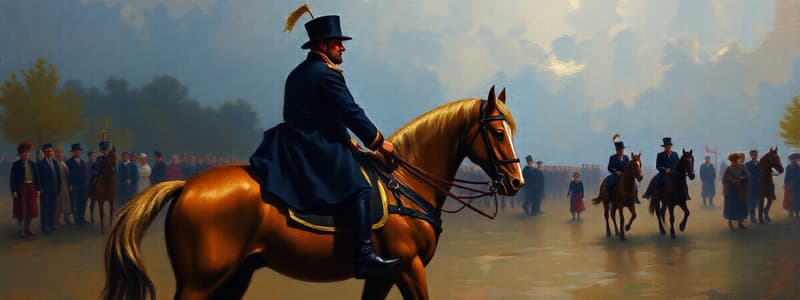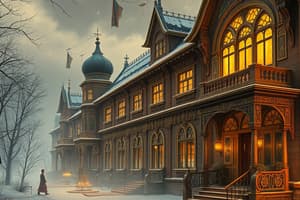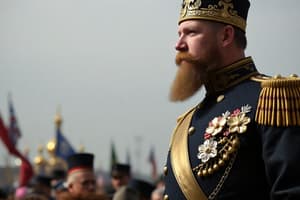Podcast
Questions and Answers
What was a significant political consequence of the unrest in Russia following 1905?
What was a significant political consequence of the unrest in Russia following 1905?
- Russia adopted a fully democratic government with universal suffrage.
- Political parties gained real influence, and a parliament was established. (correct)
- The Social Democrats, including Bolsheviks and Mensheviks, were outlawed, and their leaders exiled.
- The Tsar consolidated power by disbanding all political parties.
Nicholas II's leadership was characterized by openness to opposition and a willingness to reform Russia's political structure.
Nicholas II's leadership was characterized by openness to opposition and a willingness to reform Russia's political structure.
False (B)
What major political grouping before World War I emerged, advocating for a peasant-led revolution?
What major political grouping before World War I emerged, advocating for a peasant-led revolution?
Social Revolutionaries
The Social Democrats' ideology was based on the writings of ________, advocating for the proletariat to overthrow the bourgeoisie.
The Social Democrats' ideology was based on the writings of ________, advocating for the proletariat to overthrow the bourgeoisie.
Match the following political groups with their primary goals in early 20th century Russia:
Match the following political groups with their primary goals in early 20th century Russia:
What was the primary aim of Russia's war with Japan?
What was the primary aim of Russia's war with Japan?
The Trans-Siberian Railway significantly improved Russia's resupply efforts during the Russo-Japanese War.
The Trans-Siberian Railway significantly improved Russia's resupply efforts during the Russo-Japanese War.
What event, involving a large loss of life during Nicholas II's coronation celebrations, highlighted logistical and organizational failures early in his reign?
What event, involving a large loss of life during Nicholas II's coronation celebrations, highlighted logistical and organizational failures early in his reign?
The disastrous naval battle in the Tsushima Strait during the Russo-Japanese War led to Russia's ____________.
The disastrous naval battle in the Tsushima Strait during the Russo-Japanese War led to Russia's ____________.
What was the main demand of the workers who participated in the Bloody Sunday protest in 1905?
What was the main demand of the workers who participated in the Bloody Sunday protest in 1905?
The workers demonstrating on Bloody Sunday intended to overthrow the Tsar.
The workers demonstrating on Bloody Sunday intended to overthrow the Tsar.
Bloody Sunday led to the creation of workers' councils known as ________.
Bloody Sunday led to the creation of workers' councils known as ________.
Stolypin's policy of brutal repression was metaphorically referred to as Stolypin's ________.
Stolypin's policy of brutal repression was metaphorically referred to as Stolypin's ________.
Match each promise made in the October Manifesto with its significance:
Match each promise made in the October Manifesto with its significance:
What was the primary purpose of the October Manifesto?
What was the primary purpose of the October Manifesto?
The Fundamental Laws of the Kingdom, issued after the October Manifesto, fully implemented the promises of democratic reform.
The Fundamental Laws of the Kingdom, issued after the October Manifesto, fully implemented the promises of democratic reform.
Although the 1905 Revolution saw troops remaining loyal to the Tsar, what changed by 1917?
Although the 1905 Revolution saw troops remaining loyal to the Tsar, what changed by 1917?
Nicholas II's son suffered from _______, a condition that was kept secret from the Russian public.
Nicholas II's son suffered from _______, a condition that was kept secret from the Russian public.
Which of the following contributed to the instability in Russia during Nicholas II’s rule?
Which of the following contributed to the instability in Russia during Nicholas II’s rule?
The liberals in early 20th century Russia advocated for a violent revolution to overthrow the Tsar.
The liberals in early 20th century Russia advocated for a violent revolution to overthrow the Tsar.
What economic factor contributed to worker discontent during Nicholas II's reign?
What economic factor contributed to worker discontent during Nicholas II's reign?
The disastrous resupply efforts in the Russo-Japanese war were partly due to the ineffectiveness of the __________ railway.
The disastrous resupply efforts in the Russo-Japanese war were partly due to the ineffectiveness of the __________ railway.
What was the 'Batiushka Tsar' concept, as understood by Russian workers?
What was the 'Batiushka Tsar' concept, as understood by Russian workers?
The October Manifesto immediately resolved all social and political tensions in Russia.
The October Manifesto immediately resolved all social and political tensions in Russia.
What was the name given to the laws that undermined the promises of the October Manifesto?
What was the name given to the laws that undermined the promises of the October Manifesto?
Flashcards
Nicholas II
Nicholas II
The Tsar of Russia during a period of instability, facing famine and lacking leadership skills.
Conservatives (1905 Russia)
Conservatives (1905 Russia)
Represented the privileged classes and aimed to maintain the status quo.
Liberals (1905 Russia)
Liberals (1905 Russia)
Represented the middle class, advocating for Western-style political reforms, a constitution, parliament, and limiting the Tsar's power.
Social Revolutionaries
Social Revolutionaries
Signup and view all the flashcards
Social Democrats
Social Democrats
Signup and view all the flashcards
Bolsheviks
Bolsheviks
Signup and view all the flashcards
Economic Factors (Nicholas II)
Economic Factors (Nicholas II)
Signup and view all the flashcards
Russo-Japanese War
Russo-Japanese War
Signup and view all the flashcards
Bloody Sunday (1905)
Bloody Sunday (1905)
Signup and view all the flashcards
Soviets
Soviets
Signup and view all the flashcards
Stolypin
Stolypin
Signup and view all the flashcards
October Manifesto
October Manifesto
Signup and view all the flashcards
Fundamental Laws of the Kingdom
Fundamental Laws of the Kingdom
Signup and view all the flashcards
Study Notes
- Nicholas II's son had hemophilia, which was unknown to the Russian public.
- Nicholas II was an incompetent Tsar, and his policies were very similar to those of his predecessors.
- Russia was highly unstable during his rule, leading to the independence of Poland, the Baltics, and other regions.
- Russia experienced famine due to its backwarded agricultural development
- Nicholas II lacked leadership skills and was not open to any opposition.
- The Khodynka tragedy occurred during the rise of his power due to massive logistical issues.
Political Groupings (1905)
- After 1905, political parties gained some power, and a parliament emerged.
- Conservatives represented the privileged people of Russia.
- Liberals represented the middle classes and wanted Western-style political change, including a constitution, parliament, and limiting the Tsar’s power.
- Social Revolutionaries were a large political grouping that sought revolution in the peasant revolution style, inheriting Russian populist ideas and engaging in terrorism
- Social Democrats based their beliefs on Karl Marx that the proletariat would overthrow the rich, and despite having few members, they were very vocal
- In 1903, the Social Democrats split into Bolsheviks and Mensheviks, leading to the rise of Lenin with the Bolsheviks.
- Class consciousness allows for revolutionary consciousness.
- There are differences between proletariat and bourgeoisie, and people's perceptions of the world will change.
- Marx offered a "heaven" or paradise
- There was an idea of going west to spread the revolution to other industrialized countries, with Germany seen as ready for revolution with Russia's push.
- Russia passed to Nicholas II in a seemingly good condition.
- Rural-urban problems grew, with the population doubling and tripling within 70 years due to a demographic boom.
Economic Factors
- Heavy taxation was imposed on workers with low wages, causing discontent.
- An International Economic Slump occurred in 1902.
- Bad harvests in 1900 and 1902 added to the burden on workers.
War With Japan
- Russia engaged in war with Japan to divert attention from internal problems.
- Russia did not want to be exploited like China by western powers.
- Japan was overpopulated and lacked resources, leading to expansion and rivalry with Russia.
- Advisors suggested that a quick, victorious war would unite the people, underestimating Japan's capabilities due to Russia's modern army, navy and the Trans-Siberian Railway.
- The Siege of Port Arthur required Russia to resupply its garrison.
- The UK denied Russia access through the Mediterranean and Suez Canal to weaken them.
- The Tsushima Strait disaster occurred.
- Port Arthur surrendered, putting Russia in a difficult position.
- A peace treaty was negotiated by Americans, resulting in Korea and Port Arthur falling into Japanese hands.
- The railway resupply was slow and ineffective due to its one-way design.
- Racial language was used to fuel nationalism, making the loss even more humiliating.
The Bloody Sunday (January 1905)
- Similar to the Crimean War, the Russo-Japanese War highlighted the need for change.
- Workers complained about appalling working conditions.
- Specific demands included employer-employee discussions, an 8-hour workday, wage agreements, abolishing overtime, increasing wages for unskilled workers and women to one ruble a day, providing medical care, building shops, electing a representative government (constituent assembly), and establishing a constitution.
- The workers respected the Tsar and viewed him as a father figure
Consequences of Bloody Sunday
- Bloody Sunday caused outrage and drew people from different walks of life.
- Strikes spread across Russia.
- Mutinies occurred in certain army units but weren't widespread.
- Soviets (councils of representatives) emerged, with the Petrograd Soviet being the largest.
- The situation in Russia became very dramatic for the Tsar and his court.
Stolypin's Response
- Stolypin was appointed as the new minister and adopted a "stick and carrot" approach, including brutal reactions and reforms.
- "Stolypin’s necktie" became a metaphor for hanging.
- Soviets were dispersed, and the army was used to suppress peasant riots.
- Most of the army remained loyal to the Tsar in 1905, unlike in 1917.
October Manifesto
- The Tsar promised fundamental civil freedoms, including freedom of speech, conscience, assembly, and association.
- Participation in the Duma was granted to classes previously deprived of voting powers.
- No law could come into force without the Duma's approval, limiting the autocracy.
- The manifesto aimed to unify the government and pacify the country.
- People from different walks of life united, driven by dissatisfaction and desire for change and reforms.
- "Divide and rule" tactics were employed.
Fundamental Laws of the Kingdom
- What was promised in 1905, was covered by the Fundamental Laws of the Kingdom
- The Fundamental Laws of the Kingdom asserted that the Emperor will remain autocratic( Sovereign Emperor) .
- In democracy the people are sovereign
- Dumas would exist, but laws required ratification by the Tsar to pass.
- The loyalty of troops in 1905 contrasted with their disloyalty in 1917 during different events.
Studying That Suits You
Use AI to generate personalized quizzes and flashcards to suit your learning preferences.
Description
Tsar Nicholas II's reign was marked by political instability, famine due to agricultural backwardness, and the Khodynka tragedy. His son's hemophilia was kept secret. Political groupings emerged after 1905, including Conservatives, Liberals seeking Western-style reforms, and Social Revolutionaries.




